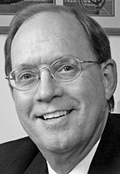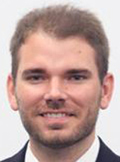MSLD students investigating value created by Chicago park

Dennis Jerke

Ryan Mikulenka

Serena Conti
Two Master of Land and Property Development students at Texas A&M traveled to Chicago in July 2011 to document how Millennium Park, a $475 million project completed in 2004, praised as a “showcase of art and urban design” by the San Francisco Chronicle, has affected the vicinity’s real estate value.
Serena N. Conti and Ryan Mikulenka teamed with two graduate students from Chicago’s DePaul University to collect data and conduct interviews with a range of subjects including landowners, users of property around the park and users of the park itself to measure how the 24.5 acre space that includes a Frank Gehry-designed bandshell and four other major artistic highlights has impacted land prices.
They used a matrix developed by Dennis Jerke ’78 in his book “Urban Design and the Bottom Line: Optimizing the Return on Perception,” that includes four factors: social/cultural value, including safety and security, public access, transportation choices and context sensitivity; economic value, including taxable value, adjacent property values and occupancy rates; environmental value, including permeable surfaces, storm water management, rainwater harvesting; and carbon footprint and sensory or visual value, including green space, public art and water features.
Jerke, who holds a Master of Landscape Architecture degree from Texas A&M and is a former principal with TBG Partners, a landscape architecture and planning firm, was recently appointed as an adjunct professor in the Department of Landscape Architecture and Urban Planning at Texas A&M. He accompanied the students.
Conti earned a Bachelor of Landscape Architecture degree at California Polytechnic State University in May 2011 with concentrations in construction management and sustainable environments. She’s planning to enter academia after earning an MLPD degree, researching efficient construction and development processes and educating visionary builders.
Mikulenka earned an Urban and Regional Planning degree from Texas State University-San Marcos in 2006 and began the MLPD program after a stint as a planner with the City of Austin in the Planning and Development Review Department. He hopes to work in a large city doing infill development projects after learning how to plan and execute financially sound and successful redevelopment ventures.
“Building Millennium Park was a significant investment, but there was a major uplift in the value of the land and the activities it generated on the land around it,” said Geoffrey Booth, coordinator of the MLPD program. “As a driver for urban value creation it’s one of the most interesting projects in the country. It’s a best practice project that clearly has applications across the United States and across the world and therefore is relevant to us here in Texas.”
The park, perhaps the Windy City’s most important project since its World’s Columbian Exposition of 1893, is the world’s largest rooftop garden, built atop a parking garage and commuter rail station.
Originally budgeted for $150 million, the city’s final construction bill was $270 million, with private donors providing the rest. A showcase for post-Modern architecture including a pavilion designed by Zaha Hadid and another Gehry design, the BP Pedestrian Bridge, the park is hailed by Frommer’s Travel Guide “as one of the four best free things to do in the city” and by the Financial Times as “a genuinely 21st-century interactive park that could trigger a new way of thinking about public outdoor spaces.”
The project was funded by Texas A&M’s College of Architecture and Department of Landscape Architecture and Urban Planning and the Landscape Architecture Foundation, a Washington, D.C. based organization that supports the preservation, improvement and enhancement of the environment.
Research findings and a video about the study were posted online and are used by MLPD students, he said.
Jerke and Suzanne Cannon, who chairs DePaul University’s Department of Real Estate, serve as members of the Urban Land Institute’s City Development Council, which facilitated the collaboration.
Tags
Related Posts

Grad LAND students design green West Campus master plan
Furr HS students gather data aiding vulnerability study
Follow Us
Facebook Twitter Vimeo Youtube Flickr RSS
Recent Posts

Planning prof heads study of disaster housing aid

A message from the dean

Former student remembered as expert planner

Leading educator named new head of Architecture Dept.













_thumbnail_small.png)
